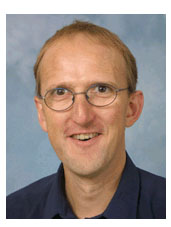NeuroCampus Aarhus / DNC Seminar: Friedemann Pulvermüller
Professor Friedemann Pulvermüller, Freie Universität Berlin will visit Aarhus and give a guest talk.
Info about event
Time
Location
Aarhus University Hospital, DNC Auditorium, Building 10G, Nørrebrogade 44
Organizer

Professor Pulvemüller's talk is entitled:
From Neuroscience to Neurorehabilitation of Language.
Abstract:
Advances in theoretical and experimental neuroscience have important implications for clinical practice. Brain research documented that the cortical mechanisms for language and action are tightly interwoven and, concurrently, new approaches to language therapy in neurological patients are being developed that implement language training in the context of relevant linguistic and non-linguistic actions, therefore taking advantage of the mutual connections of language and action systems in the brain (1).
A further well-known neuroscience principle is that learning at the neuronal level is driven by correlation of neural activity; consequently, new approaches to language therapy emphasize massed practice in a short time, thus maximizing therapy quantity and frequency and, therefore, correlation at the behavioral and neuronal levels. Learned nonuse of unsuccessful actions plays a major role in the chronification of neurological deficits and behavioral approaches to therapy have therefore employed shaping and other learning techniques to counteract such nonuse.
These insights from neuroscience combine to yield a new kind of therapy approach to post-stroke aphasia, called constraint-induced aphasia therapy or intensive language-action therapy (ILAT) (2,3).
Whereas classical wisdom had been that post-stroke aphasia cannot be significantly improved at a chronic stage, a short intensive training interval (2 weeks, 2 hours/day) of ILAT yields significant improvement of language performance in patients with chronic aphasia, several years after their stroke (4). The method has recently been improved further by applying drug treatment in conjunction with the behavioral training (5).
ILAT now appears as an efficient tool for improving language functions, even at chronic stages of aphasia. In future, we will aim to further optimize the method, strive to understand its underlying mechanisms and explore its perspectives with regard to a spectrum of communicative and cognitive deficits (6).
As a further benefit, ILAT as a rapid effective technique for language therapy in chronic post-stroke aphasia provides a unique tool for exploring the cortical reorganization of language independent of any spontaneous restitution processes. Therefore, therapy studies using this technique can open new perspectives for research into the plasticity of human language circuits (2,3).
- Pulvermüller, F., & Fadiga, L. (2010). Active perception: Sensorimotor circuits as a cortical basis for language. Nature Reviews Neuroscience, 11(5), 351-360.
- Pulvermüller, F., & Berthier, M. L. (2008). Aphasia therapy on a neuroscience basis. Aphasiology, 22(6), 563-599.
- Berthier, M. L., & Pulvermüller, F. (2011). Neuroscience insights improve neurorehabilitation of post-stroke aphasia. Nature Reviews Neurology, 7(2), 86-97.
- Pulvermüller, F., Neininger, B., Elbert, T., Mohr, B., Rockstroh, B., Koebbel, P., & Taub, E. (2001). Constraint-induced therapy of chronic aphasia following stroke. Stroke, 32(7), 1621-1626.
- Berthier, M. L., Green, C., Lara, J. P., Higueras, C., Barbancho, M. A., Davila, G., & Pulvermuller, F. (2009). Memantine and constraint-induced aphasia therapy in chronic poststroke aphasia. Ann Neurol, 65(5), 577-585.
- DiFrancesco, S., Pulvermüller, F., & Mohr, B. (2012). Intensive language action therapy: the methods. Aphasiology, 26(11), 1317-1351.
Read more about Professor Pulvemüller
After the guest talk the DNC will offer refreshments (coffe and cake) in front of the auditorium.
ALL ARE WELCOME.
